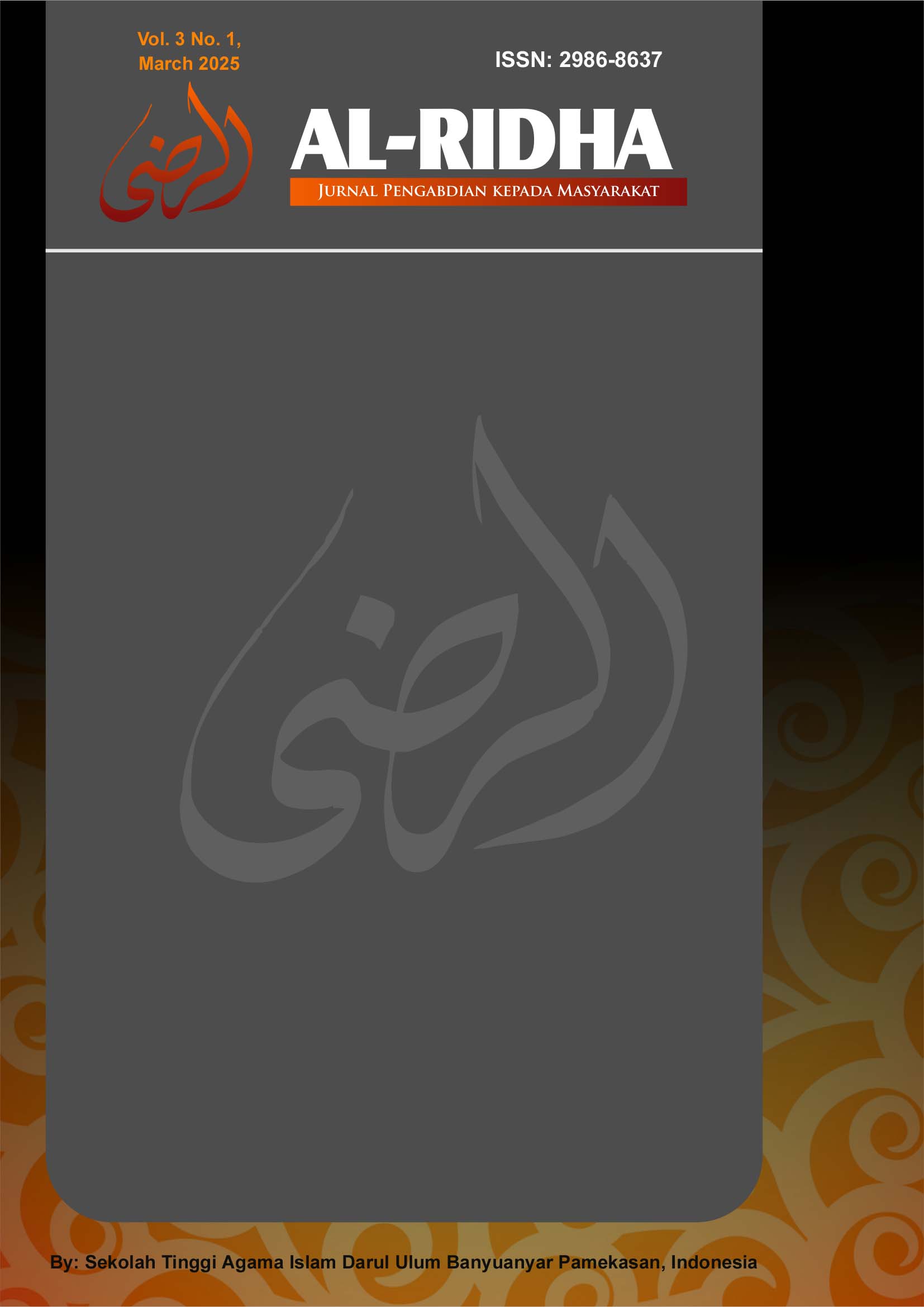Assisting Teachers in Developing Qirā’ah Learning Materials Based on Message Design Principles
DOI:
https://doi.org/10.58223/al-ridha.v3i1.583Keywords:
Qiraah, Message Design, Arabic language, Semiotics, teacher mentoringAbstract
The teaching of Qirā’ah (Arabic reading comprehension) at STAI Darul Ulum Banyuanyar Pamekasan has long faced challenges due to the use of monotonous and text-heavy learning materials. The existing textbooks consist mainly of reading passages and simple exercises that fail to attract students’ interest or encourage autonomous learning beyond the classroom. This community service project aimed to assist Arabic language teachers in developing Qirā’ah learning materials based on message design principles, emphasizing clarity, visual appeal, and pedagogical effectiveness. A participatory mentoring approach was employed, involving workshops, collaborative material design, and expert validation led by Dr. Jiddah Hassan Muhammad from the University of Maiduguri, Nigeria. Data were collected through observation, documentation, and focus group discussions, and analyzed qualitatively using Miles and Huberman’s interactive model. The findings revealed significant improvement in teachers’ ability to integrate design elements and semiotic principles—particularly Peirce’s triadic model of icon, index, and symbol—into their instructional materials. The newly developed Qirā’ah resources showed increased visual coherence and motivational value, resulting in greater student engagement and comprehension. The mentoring process also fostered cross-cultural academic collaboration, enhancing pedagogical insight and professional competence among participating teachers. This project contributes to Arabic education by demonstrating how message design theory and semiotics can be effectively applied to religious and linguistic learning contexts, bridging the gap between traditional textual instruction and modern educational design
References
Ahmad, N. (2021). Innovative approaches to Arabic reading instruction: Challenges and strategies. Journal of Arabic Pedagogy, 8(2), 45–60.
Al-Ajmi, S., & Hassan, M. (2021). The role of visual design in enhancing Arabic reading comprehension. Arab World English Journal (AWEJ), 12(4), 88–102.
Al-Farisi, R. (2021). The effectiveness of designed Arabic textbooks in promoting reading interest. Journal of Language and Education Research, 9(1), 55–67.
Bringle, R. G., & Hatcher, J. A. (2011). International service learning: Conceptual frameworks and research. Stylus Publishing.
Chandler, D. (2017). Semiotics: The basics (3rd ed.). Routledge.
Clark, R. C., & Mayer, R. E. (2016). E-learning and the science of instruction: Proven guidelines for consumers and designers of multimedia learning (4th ed.). Wiley.
Creswell, J. W., & Poth, C. N. (2018). Qualitative inquiry and research design: Choosing among five approaches (4th ed.). SAGE Publications.
Hamdan, M. (2020). Multimedia-assisted learning in Arabic reading: A quasi-experimental study. International Journal of Language Education, 4(3), 112–125.
Hamdani, A. (2021). Teachers’ readiness in developing Arabic instructional materials: A case study in Indonesian Islamic colleges. Al-Ta’dib Journal, 14(1), 33–47.
Kress, G., & van Leeuwen, T. (2006). Reading images: The grammar of visual design (2nd ed.). Routledge.
.Mahmoud, F., & Idris, H. (2020). Pedagogical design of Arabic reading materials: A critical review. Language Teaching Research Quarterly, 5(2), 22–39.
Mayer, R. E. (2017). Multimedia learning (3rd ed.). Cambridge University Press.
Miles, M. B., Huberman, A. M., & Saldaña, J. (2014). Qualitative data analysis: A methods sourcebook (3rd ed.). SAGE Publications.
Morrison, G. R., Ross, S. M., & Kemp, J. E. (2019). Designing effective instruction (8th ed.). Wiley.
Muhammad, J. H. (2023). Mentorship and validation in Arabic language pedagogy: A cross-institutional approach. University of Maiduguri Press.
Paivio, A. (2014). Mind and its evolution: A dual coding theoretical approach. Psychology Press.
Peirce, C. S. (1955). Philosophical writings of Peirce (J. Buchler, Ed.). Dover Publications.
Peirce, C. S. (1998). The essential Peirce: Selected philosophical writings (Vol. 2). Indiana University Press.
Rahman, M., & Nurdin, F. (2022). Teacher perception of Arabic reading instruction challenges in Islamic higher education. Journal of Islamic Education Studies, 6(1), Bringle, R. G., & Hatcher, J. A. (2011). International service learning: Conceptual frameworks and research. Stylus Publishing.
Reigeluth, C. M., & Carr-Chellman, A. A. (2009). Instructional-design theories and models: Building a common knowledge base (Vol. 3). Routledge.
Stringer, E. T. (2014). Action research (4th ed.). SAGE Publications.
Downloads
Published
How to Cite
Issue
Section
License
Copyright (c) 2025 Al-Ridha: Jurnal Pengabdian kepada Masyarakat

This work is licensed under a Creative Commons Attribution-NonCommercial 4.0 International License.


